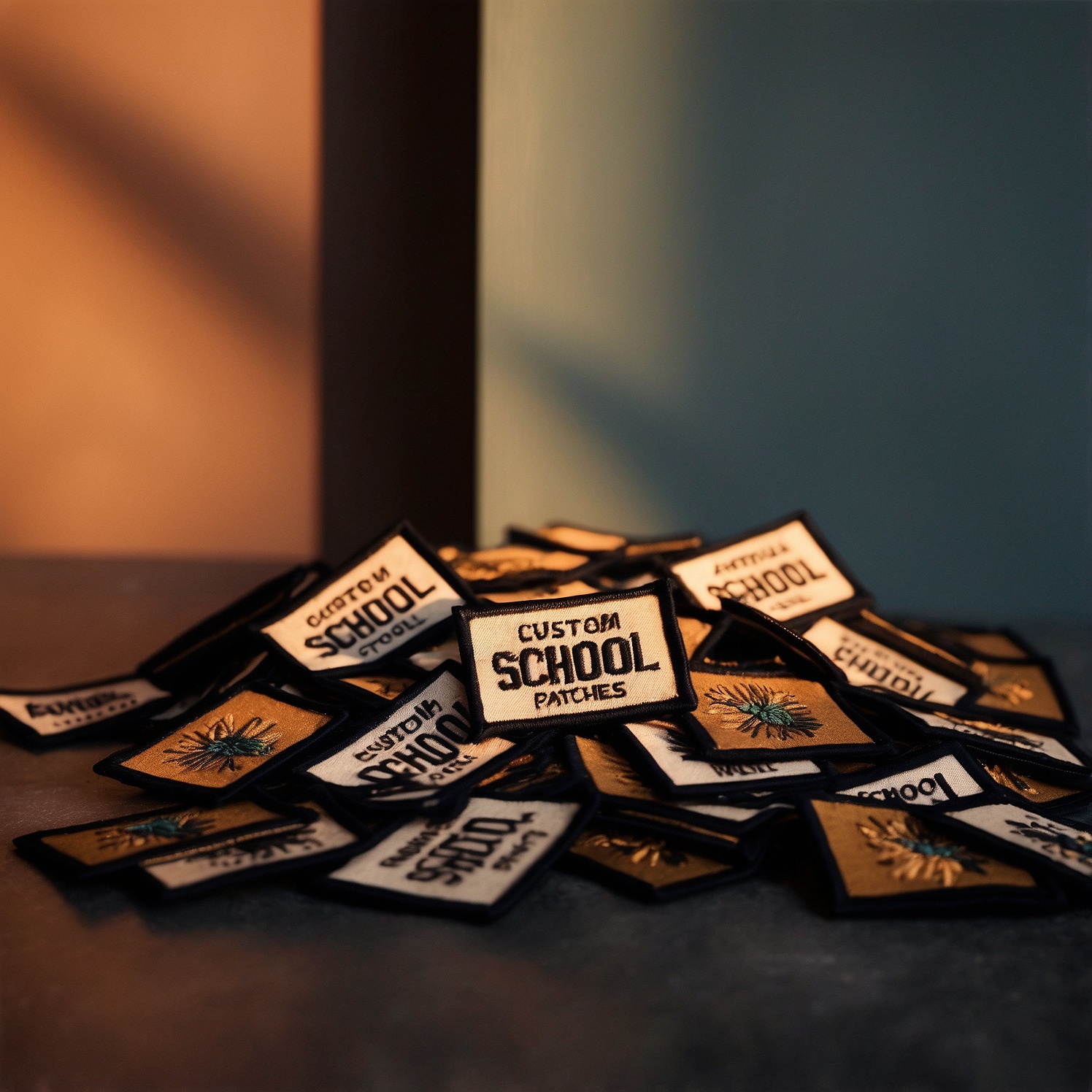Schools are more than just places for learning—they are communities where students develop their identities, create lasting memories, and take part in traditions that help shape their futures. From sports teams to academic honors, school events, and extracurricular activities, students engage in a wide variety of experiences that build character, leadership, and a sense of belonging. A critical part of this culture and tradition is represented through school patches, which are worn with pride on jackets, uniforms, backpacks, and other apparel.
School patches have long been symbols of achievement, pride, and affiliation. They tell the stories of students’ academic successes, athletic victories, and contributions to the school community. But these patches go beyond mere decoration—they encapsulate memories, forge connections, and build a sense of identity within the school’s tradition. Each patch, whether it’s for a sports team, a club, or an academic honor, carries a narrative that reflects the values and history of the school.
In this article, we will explore the importance of school patches in creating and maintaining school traditions. We’ll look at how patches are designed, what they represent, and how they help to build a lasting legacy within a school’s culture. From the creation of letterman jackets to commemorative event patches, school patches are much more than symbols—they are threads that weave together stories of achievement, camaraderie, and pride.
The History of School Patches
The tradition of school patches can be traced back over a century, particularly to the American high school and collegiate system. The origins of these patches are deeply connected to varsity letters, which were first introduced in the late 19th century. Harvard University is credited with popularizing the idea of lettermen sweaters and jackets, where athletes were awarded a cloth letter patch (typically the first letter of the school’s name) for excellence in sports. These letters were sewn onto sweaters or jackets, signifying the athlete’s contributions to the team.
The letterman jacket, as we know it today, evolved from these varsity letter patches. By the early 20th century, high schools and colleges across the country adopted similar practices, and athletes began earning patches not only for sports but for academic and extracurricular achievements. These school patches became symbols of excellence, awarded to students who demonstrated skill, leadership, or dedication in a particular field.
As time went on, school patches diversified. They became associated with more than just athletic prowess—schools began creating patches for academic honors, music programs, theater productions, and community service activities. Today, school patches are used to recognize a wide range of accomplishments and are considered integral to the overall identity and tradition of schools worldwide.
The Role of School Patches in Building Tradition and Pride
Schools use school patches to build a sense of tradition, pride, and unity among their students. Each patch tells a story—whether it’s a story of athletic excellence, academic success, or a commitment to the school’s values. Here are some of the key ways that school patches contribute to the culture and traditions of schools:
1. Celebrating Achievement
One of the most significant roles of school patches is to celebrate achievement. Whether it’s excelling in academics, winning a sports championship, or being a leader in extracurricular activities, school patches serve as visible markers of success. These patches aren’t just awarded—they’re earned, often through hard work, dedication, and perseverance.
For athletes, earning a varsity letter or a sports patch symbolizes their contributions to the team. These patches can include symbols of their sport (such as a football, basketball, or track shoe), along with the year or season they participated. Academic school patches can reflect a student’s outstanding performance in areas like mathematics, science, or language arts, often featuring symbols like books, globes, or graduation caps.
In many schools, patches for extracurricular activities are equally important. Whether it’s for participation in a debate team, the drama club, or a marching band, these patches recognize the time, effort, and passion students put into their interests. Each patch tells a story of achievement and provides tangible recognition of the student’s hard work.
2. Building School Spirit and Unity
School patches are not just about individual achievement—they also play a critical role in building school spirit and unity. When students wear patches that represent their school, they are publicly showing their pride in their institution. This fosters a sense of belonging and helps strengthen bonds within the school community.
Varsity jackets adorned with school patches are iconic symbols of school pride. They visually unify students who have earned the right to wear them and create a shared sense of identity. Students wearing patches for their sports team, club, or academic honors are immediately connected to others with similar achievements. This sense of camaraderie extends beyond graduation, with alumni often keeping their jackets and patches as mementos of their time in school.
Beyond the individual, school patches also help create school traditions that are passed down through generations. As students strive to earn patches year after year, they contribute to a culture of excellence and achievement. Schools often create events or ceremonies where patches are awarded, reinforcing the importance of tradition and creating lasting memories for the students who receive them.
3. Inspiring Future Generations
School patches have the power to inspire future generations of students. Seeing older students wear patches for academic, athletic, or extracurricular achievements serves as motivation for younger students to strive for similar success. Patches tell a story not only of the individual’s journey but also of the school’s broader values—whether it’s a commitment to excellence, leadership, or community involvement.
In many schools, younger students look up to varsity athletes, student leaders, and academic achievers who wear school patches as role models. The visible reminder of what can be achieved within the school inspires others to work hard and participate actively in school life. It also reinforces the idea that success comes from dedication, teamwork, and perseverance.
Additionally, when alumni return to visit their school, they often wear or display their old varsity jackets or school patches. This continuation of tradition across generations helps to preserve the school’s culture and ensures that new students understand the importance of earning their place in the school’s history.
4. Creating Memories and Lasting Legacies
School custom patches are more than just markers of achievement—they become cherished mementos of a student’s school experience. Years after graduation, former students often look back at their patches as reminders of their time spent on the field, in the classroom, or working on a school production. These patches represent a tangible connection to their past, a story that they carry with them long after their school days are over.
For schools, patches also help build a lasting legacy. Schools with a long history of awarding school patches create a sense of continuity, linking current students with those who came before them. When a school creates patches to commemorate major events, like a championship win or an academic milestone, they are documenting the school’s history. These patches serve as physical reminders of the school’s achievements and the students who contributed to its legacy.
For example, a high school might create a special school patch to commemorate its centennial anniversary, featuring the school’s founding date and iconic symbols. Years later, alumni who earned that patch will remember being part of a historic moment for their school. In this way, school patches help to preserve the traditions and stories that make each school unique.
Designing School Patches That Tell a Story
Designing a school patch that tells a story requires creativity, thoughtful symbolism, and attention to detail. Each patch should reflect the school’s identity and the achievement or event it represents. Here are the key elements to consider when designing school patches:
1. Incorporating Symbols and Icons
Symbols play a crucial role in the design of custom school patches. A well-designed patch uses imagery to tell a story or represent a specific achievement. For example, a sports team patch might feature the school’s mascot along with a symbol of the sport, such as a basketball for the basketball team or a helmet for the football team.
When designing patches for academic or extracurricular activities, it’s important to choose symbols that reflect the nature of the achievement. For example, a patch awarded for academic excellence might feature an open book or a graduation cap, while a patch for the drama club might include a pair of theater masks. These symbols immediately communicate the significance of the patch and help to visually tie it to the activity or accomplishment.
2. Choosing Colors That Represent the School
Colors are an essential part of any school patch design. Most patches are created using the school’s official colors, ensuring that the patch is easily recognizable as part of the school’s identity. For instance, a school with blue and gold as its primary colors will often design patches that incorporate these colors to reinforce the connection to the school.
In addition to the school colors, patches can include accent colors that highlight specific details or differentiate between different levels of achievement. For example, a school might award different colored patches to students who achieve varying levels of success in a subject or sport—gold for the highest achievement, silver for second place, and bronze for third.
The use of color is not just aesthetic—it helps to visually distinguish between different types of achievements and adds to the overall impact of the patch.
3. Including the School’s Logo or Emblem
A school’s logo or emblem is often the centerpiece of a school patch design. Including the logo reinforces the school’s identity and creates a sense of unity among students who wear the patch. Whether it’s the school’s mascot, crest, or monogram, the logo serves as a recognizable symbol that ties the patch to the school.
For example, a patch awarded to members of a school’s marching band might feature the school’s crest in the center, surrounded by musical notes or instruments. Similarly, a patch for a sports team might prominently display the school’s mascot, with the year of achievement or the team’s name incorporated into the design.
Including the school’s logo or emblem ensures that the patch is not just a representation of individual achievement but also a reflection of the student’s connection to the school as a whole.
4. Adding Text to Highlight Achievements
Text is another important element in the design of school patches. Including the name of the activity, event, or achievement adds context to the patch and makes it clear what the patch represents. For example, a patch awarded for academic excellence might include the words “Honor Roll” or “Valedictorian,” while a sports patch might include the name of the team and the year they won a championship.
In some cases, patches are designed with custom text to reflect individual achievements. For instance, a student who serves as the captain of a sports team might receive a patch that includes the word “Captain” along with the team’s name. This personalization adds an extra layer of significance to the patch and highlights the student’s leadership role.
5. Creating Unique Patches for Special Events
While many school patches are awarded for recurring achievements, such as academic honors or participation in a sports team, schools often create unique patches to commemorate special events. These patches are designed to capture the significance of the event and serve as lasting mementos for those who participated.
For example, a school might create a special patch to celebrate the opening of a new campus building or the anniversary of the school’s founding. These patches often include the date of the event and symbols that represent the occasion. For students, receiving a patch for a once-in-a-lifetime event creates a lasting memory and reinforces their connection to the school’s history.
Examples of School Patches That Tell a Story
To understand the impact of school patches and how they tell a story, let’s explore a few real-world examples of patches that schools have used to create traditions and celebrate achievements.
Letterman Jackets: A Tradition of Athletic Excellence
One of the most iconic uses of school patches is the letterman jacket. These jackets, traditionally awarded to high school or college athletes, feature a large patch in the shape of the school’s first letter. Additional patches are added to the jacket to commemorate the athlete’s achievements, such as championships, all-state honors, or participation in multiple sports.
Letterman jackets are more than just symbols of athletic success—they tell the story of the athlete’s journey through high school or college sports. Each patch represents a season of hard work, dedication, and teamwork, and wearing the jacket serves as a source of pride for the student and the school community.
Honor Roll and Academic Achievement Patches
Many schools use school patches to recognize academic excellence, awarding patches to students who achieve high grades or are named to the honor roll. These patches often feature symbols like books, graduation caps, or laurel wreaths, and they are worn on jackets, sweaters, or backpacks.
For students, earning an academic achievement patch is a tangible reward for their hard work and dedication to their studies. It also serves as a motivator for other students to strive for excellence and be recognized for their efforts.
Club and Extracurricular Activity Patches
In addition to academics and sports, school patches are commonly used to recognize participation in clubs and extracurricular activities. Whether it’s a debate team, drama club, or student government, students who take an active role in their school’s extracurricular offerings can earn patches that reflect their involvement.
These patches often include symbols related to the activity, such as theater masks for drama club or gavels for debate team members. For students, wearing these patches shows their commitment to their interests and their contribution to the school’s community.
Commemorative Event Patches
Schools often create school patches to commemorate significant events, such as anniversaries, festivals, or major milestones. These patches are designed to capture the essence of the event and serve as keepsakes for students, staff, and alumni.
For example, a school celebrating its 50th anniversary might design a special patch featuring the school’s crest and the number “50” to mark the occasion. Students who participate in the celebration receive the patch as a reminder of the event and their place in the school’s history.
School Patches as Symbols of Tradition and Achievement
School patches are more than just pieces of embroidered fabric—they are symbols of achievement, pride, and tradition. Whether they are awarded for academic success, athletic excellence, or participation in extracurricular activities, these patches tell the story of a student’s journey through school. They provide tangible recognition for hard work and dedication, while also fostering a sense of community, unity, and belonging.
As schools continue to use school patches to celebrate achievements and create lasting traditions, these small yet powerful symbols will remain a key part of school culture. They serve as markers of individual success and collective pride, helping students forge memories and connections that last a lifetime. For the students who earn them, school patches are not just awards—they are threads that tie them to the rich history and tradition of their school.
If you are interested in ordering some high-quality custom patches, feel free to call us at 877-912-6407 or fill out a FREE quote here.




